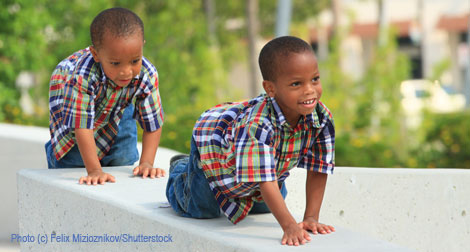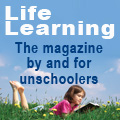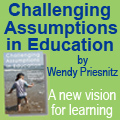|

Playful Play
by Bernie De Koven
Some of the most fun we have when we play happens when we are alone where no one else can see us. And, for some reason, it’s often even more fun when we’re some place we’re not supposed to be. This is true for all of us, kids, adults, all of us.
The reason why it tends to be more fun is that what we can do, unseen, is play, really play. And as soon as somebody happens by, someone who’s not playing, just watching, unless we’re already deep in play, so deep that we don’t notice, the way we play changes into something else. It becomes what you might call a performance. Social beings that we are, we want to include the other people in our play. And if they can’t play, if they don’t join in, if they just want to watch, something changes in the way we play. We get into a different mode, into something you might call “showing off.”
Another word for showing off is performing. And that’s really what happens to our play; it becomes a performance. So we focus less on each other than we do on the people watching us. Sure, we’re still playing, and we’re playing together. But just not in the same way. It becomes like we would play if we were playing a sport, in a stadium. Or if we were playing music, in a theater. Instead of just, you know, playing around, we want to be good, we want to get applause, recognition. We want to play for score. And we want to win.
Our play becomes more purposeful, less playful. We don’t laugh as much or maybe at all, we don’t try out new ways to play whatever we’re playing, if playing is still what we’re doing.
Now, before I go any further into this, I want to make it clear that I’m not implying here. I’m not even hinting that one way is better than another. Not play vs. playfulness. Not play vs. performance. In truth, some performers are remarkably playful even though they are performing, or especially because. Improvisers mostly. Musicians, comedians, who can perform publicly with such confidence and competence that they don’t need script or score, and can even engage the audience in playing along with the sheer playfulness of their performance. But they are nevertheless performing. And the way they play is nevertheless different when nobody can see them, when they play alone.
I certainly played this way as a child. Improvising, in hidden places, with my friends. We played games that didn’t have names, didn’t have rules. Well, maybe a few, but we could change them if we wanted, if it was more fun.
As a young adult, I fell in deep like with theater. It was fun. It was exciting even. But it wasn’t until I was in a class in improvisational theater that I was reminded of the kind of play I experienced as a child, when we were alone together. And that was when I discovered the power of adults at play, Of what we could bring each other, as adults, in play. Not when we were performing. But when we were learning together. The stage to ourselves. The theater empty except for us. Nobody watching except fellow players. It was only a taste. We were after all still performing. And there was the instructor. And we were playing for grades. But the playfulness, the power that we shared, making worlds together, responding to whatever anyone did, listening to each other, building fantasy into something remarkably close to reality, building it together, almost believing it together. It was better, deeper than the way I played as a child. It was transforming. For all of us. Individually. Collectively transforming.
I really, really loved playing like that. So profoundly playful. So playfully profound.
Then I rediscovered games – you know, games like kids play. And I got to teach those games to adults. And then, while teaching those games to adults – not so much so that they could learn the games, but so they could taste and share that experience of play (not performance, play) – it got, from time to time, so much fun, we got so totally playful that it just about almost felt like the whole world had become new again. And lo, it was transforming, transporting, transcendent. And we laughed a lot and we learned a lot and we freed each other. Just like we did in improv class. Just like we did when we were kids and we thought nobody could was watching. We freed each other and became infinite and it was fun.
Since then, I’ve been teaching that kind of play everywhere with anyone who wanted to learn it. I’ve also been trying to find a name for the way we played when we played that way. Play wasn’t enough. Neither was games. The games played weren’t really that relevant, couldn’t really begin to describe the experience we had playing together. And the words play and games really didn’t work, had just too many other meanings. I mean, they’re being used to mean almost the very opposite of what I mean. Playing someone. Getting played. Getting gamed. Meaning broken promises. Broken relationships. Broken faith. When the kind of play I’m talking about is just the opposite of that. Completely.
Lately, I’ve been liking “playful play.” Still play, but playful. Still playful, but play. Not quite infinite, like Carse’s “Infinite Games.” Not necessarily creative, but playful. Not like sports. More like, you know, play.
* * *
Playful play requires a measured abandon, a passionate, conscious embrace of a state of mind and body that expresses itself in the manner to which my friend Brian has so gleefully referred as: “cries of exultant commitment.” We give ourselves over, absent ourselves from all that is not felicity, embracing not just the game, but our fellow players; not just the goals but each moment of play.
If I tried to sum up everything I’ve been teaching or seeking to teach in my last fifty years of sociospiritual entrepreneurship, if I dared attempt to encapsulate the experience that drew me to improvisational theater, children’s games, large-scale community events, human potential workshops, and retreats, I think those are precisely the two words I’d use. It was, in fact, the very idea of playful play that led me to writing the book A Playful Path.
For adult human beings, playful play, play that is accompanied by a positive mood in which we are inclined to behave and think in a spontaneous and flexible way, is most often pursued only under the influence of mind altering substances. And, I can now almost readily admit, that it was those very same substances that led, much earlier in my career, to my qualified success as a guru of glee. Not, mind you, because of my particular partaking, but more because these substances gave rise to a subculture in which spontaneity was the sine qua something of the life we were so passionately imagining into existence.
Paddy Cake
I was in a third grade classroom, teaching some games from my freshly printed Interplay Games Catalog. I had a video camera with me (a rare find in the late 1960s, one that I had to explain, in detail, my need for; promise, in even greater detail, when I would return it; sign things, in triplicate, before I could get the AV department to trust me with). After playing several games with them, I, as was my wont, explained that I wanted to take pictures of them at play with my camera, and invited them to show me some of their favorite games.
Almost as soon as the words came out of my mouth, this girl jumped up and started playing some kind of advanced paddy cake with one of her friends – slapping various parts of each other’s bodies, turning around, touching the ground, swinging hips. I would estimate that within two minutes everyone in the room was playing one form of paddy cake or another.
Follow the Leader
By the time just about every kid was playing some variation of paddy cake or paddy-cake-like game, the girl who started the whole thing, together with her partner, started parading around the room, weaving between desks and other players, singing, laughing. And, sure enough, other kids joined in. And then, as soon as she noticed that almost everyone was following her, she started doing the craziest things, crawling under tables, jumping, skipping. And the other kids did their best to keep up, to do exactly what she was doing, moment by moment.
And she managed to make her leadership constantly enticing, an open-ended invitation for everyone to play, doing something just long enough for all the other kids to catch up, and then, as soon as she noticed someone getting the least bit bored, changing.
It wasn’t like she was leading, but more like she was following the followers, always staying just ahead of people losing interest, just below doing things that the kids had too much trouble following.
The Real Game is Never Played the Same Way Twice
Some children are unusually gifted players, not just at being good leaders, but at having a good sense of play, at keeping people engaged, at invention, at changing things as soon as they needed to be changed, and no sooner. Some children are so responsive to others, so playful, that all the kids who follow them feel safe, feel invited, understand that if they don’t want to follow they don’t have to follow, if they want to quit, they can, if they wanted to come join again, they can do that, too. And whatever they did was fine. No judgment. No rules. And it all feels so spontaneous, so natural.
I probably wouldn’t have learned so much, have been so amazed at the play leadership and followership skills that these kids had, have been so struck by the creativity and sensitivity of their play, if I hadn’t been trapped behind the camera into having to do nothing but observe. And, in retrospect, I probably wouldn’t have seen so clearly what those kids were teaching me during the years I was working with them on my games curriculum. The rules that anyone talks about when talking about kids’ games are just suggestions, just starting points, generalities to be interpreted anew each time the game is played. The real game is never played the same way twice.
Duck Duck Goose
Duck, Duck, Goose, for example – one of the first games kids taught me. For schematic purposes, here’s how it’s more or less played:
Everyone sits or stands in a circle, and one kid, the Fox, walks around the outside of the circle, tapping each kid on the head and saying “Duck” until she reaches the one kid she wants to get chased by. She calls the kid “Goose.” The Goose stands up and gives chase. If she tags the Fox before getting to her vacated seat, the Fox has to start over again. If she makes it back to her seat, untagged, the kid that got Goosed is, once again, a happy little Duck. Those are the rules. But that’s not, necessarily, how the game gets played.
For example, the Goose might suddenly turn around, run the other way, and jump into her place in the circle before the other Fox can even complete changing direction. Or the Goose might run right past his place and chase after the kid who was supposed to be chasing after him. Or two kids might “accidentally” get up at the same time and maybe run in opposite directions. Or maybe run across the circle instead of around it.
To Play Playfully You Need More Than Rules
Sure, sometimes what the kids did was just too, well, playful. The other kids couldn’t figure out how to play along. So, usually, they’d want to play something else after that. A lot easier than arguing over the “real” rules, when, in truth, there aren’t any.
And tag, and hide and seek, and hand-clapping games, and hopscotch, and jumprope, and marbles – so many different rules, different interpretations, different strategies, different variations. Because to play playfully you need more than rules. Or, just as often, less.
In 1971, Bernie De Koven completed a collection of over 1,000 children’s games, organized according to different forms and complexities of social interaction. Called the Interplay Games Curriculum, and published by the School District of Philadelphia, it led to his founding of The Games Preserve, a retreat center for the exploration of games and play for adults, which functioned as a branch of The New Games Foundation. In 1978, he published “The Well-Played Game,” which was re-released by MIT Press in 2013. His most recent book “A Playful Path” was published the following year. He has designed games of all kinds, for couples, families, children, elders. But his greatest impact has been his development of a theory of fun and playfulness, which can affect every aspect of personal and interpersonal, community, and institutional health.
Copyright © Life Media
Privacy Policy
 



|

